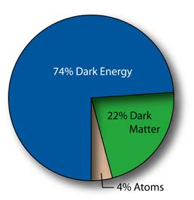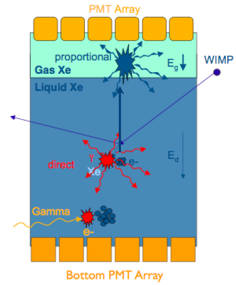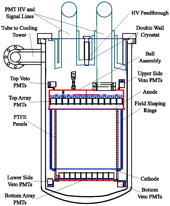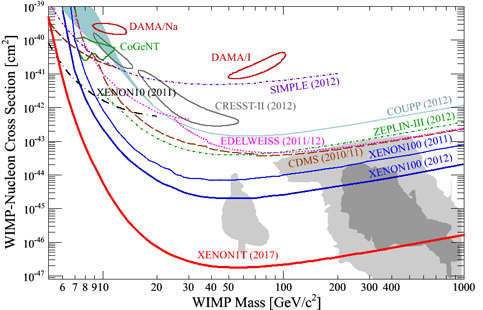NEW - July 18, 2012 - XENON100 sets record limits for dark matter. Press release (Italian version) (English version)
Click here for the official XENON website: http://xenon.astro.columbia.edu
Dark Matter
 The XENON experiment is dedicated to the direct detection of the dark matter in the Universe. Astronomical evidence indicates that about 22% of the Universe is made up of non-baryonic dark matter. Several lines of arguments indicate that dark matter consists of Weakly Interacting Massive Particles (WIMPs), exotic relics of the Big Bang that exist till today due to their weak interactions with ordinary matter. A well-motivated WIMP candidate is the neutralino, the lightest particle predicted by Supersymmetry (SUSY). Understanding the nature of the dark matter is one of the most important open questions in cosmology, astrophysics and particle physics today.
The XENON experiment is dedicated to the direct detection of the dark matter in the Universe. Astronomical evidence indicates that about 22% of the Universe is made up of non-baryonic dark matter. Several lines of arguments indicate that dark matter consists of Weakly Interacting Massive Particles (WIMPs), exotic relics of the Big Bang that exist till today due to their weak interactions with ordinary matter. A well-motivated WIMP candidate is the neutralino, the lightest particle predicted by Supersymmetry (SUSY). Understanding the nature of the dark matter is one of the most important open questions in cosmology, astrophysics and particle physics today.
Detection principles
 XENON is a direct dark matter detection experiment using liquid xenon as the detector medium. The goal is to detect the small charge and light signal after a dark matter particle interaction with a xenon nucleus in a liquid-gas two-phase time projection chamber (TPC): the prompt light signal (S1) is detected with two array of photomultipliers. The ionization electrons are separated from the Xe ions and drifted upwards by a strong electric field. A second electric field extracts the charges from the liquid into the gas phase where they generate secondary scintillation light (S2) which is proportional to the charge signal. The secondary signal -- delayed to the S1 by the electron drift time -- is detected with the same two photodetector arrays.
XENON is a direct dark matter detection experiment using liquid xenon as the detector medium. The goal is to detect the small charge and light signal after a dark matter particle interaction with a xenon nucleus in a liquid-gas two-phase time projection chamber (TPC): the prompt light signal (S1) is detected with two array of photomultipliers. The ionization electrons are separated from the Xe ions and drifted upwards by a strong electric field. A second electric field extracts the charges from the liquid into the gas phase where they generate secondary scintillation light (S2) which is proportional to the charge signal. The secondary signal -- delayed to the S1 by the electron drift time -- is detected with the same two photodetector arrays.
The TPC design allows the precise 3-dimensional reconstruction of the interaction vertex which can be used to reduce the background contamination by fiducial volume cuts. Furthermore, the ratio S2/S1 has a different value for electron recoils (background) and nuclear recoils (signal) and can be used for background discrimination.
The XENON program
The first module -- XENON10 -- has been successfully operated in dark matter mode at the Gran Sasso Underground Laboratory (LNGS) until 2007 leading to some of the best limits on WIMP dark matter so far (Phys. Rev. Lett. 100, 2008 and Phys. Rev. Lett. 101, 2008).
The second module -- XENON100 – with an increased fiducial mass of 65 kg and a 100 times reduced background rate, started science runs in 2009 and is currently taking data at LNGS: the analysis of 100 live days has been presented in April 2011 (http://arxiv.org/abs/1104.2549). The data acquisition is ongoing to reach the planned sensitivity of 2 x 10-45 cm2 .
An upgrade to the current effort with a target mass of 1 ton -- XENON1T -- is already funded and in the planning phase. In April 2011 it has been approved by the INFN and the construction is foreseen to start in fall 2011 in the hall B of the LNGS.
XENON100 Detector
 The XENON100 detector uses the same principle of operation and many design features successfully tested in the XENON10 prototype. It is a position-sensitive XeTPC, with the sensitive LXe volume viewed by two arrays of total 178 photomultiplier tubes (PMTs), to detect simultaneously the primary scintillation signal (S1) and the ionization signal via the proportional scintillation mechanism (S2). The active target is enclosed in a PTFE cylinder of 15 cm radius and 30 cm height. This PTFE cylinder reflects scintillation light with high efficiency, and optically separates the LXe target from the surrounding LXe which is necessary to separate the TPC with its electric field from the walls of the vessel. 64 PMTs turn this outer LXe volume into an active LXe veto, with a total mass of 105 kg, including LXe layers above the top and below the bottom PMT arrays.
The XENON100 detector uses the same principle of operation and many design features successfully tested in the XENON10 prototype. It is a position-sensitive XeTPC, with the sensitive LXe volume viewed by two arrays of total 178 photomultiplier tubes (PMTs), to detect simultaneously the primary scintillation signal (S1) and the ionization signal via the proportional scintillation mechanism (S2). The active target is enclosed in a PTFE cylinder of 15 cm radius and 30 cm height. This PTFE cylinder reflects scintillation light with high efficiency, and optically separates the LXe target from the surrounding LXe which is necessary to separate the TPC with its electric field from the walls of the vessel. 64 PMTs turn this outer LXe volume into an active LXe veto, with a total mass of 105 kg, including LXe layers above the top and below the bottom PMT arrays.
 The materials used in the XENON100 TPC and shield were carefully selected for low intrinsic radioactivity. The sensitive target can be "fiducialized" to keep only the inner core free of background. Monte Carlo simulations, based on these measured radioactivity, predict an electron recoil background rate to be less than 3 mDRU (mDRU = 10-3 evts/keVee/kg/day) in the 30-kg inner fiducial target. Such a low background rate enables us to search for WIMPs with a raw exposure of 6000 kg-day with no gamma background event. The nuclear recoil background produced by neutrons will be even less.
The materials used in the XENON100 TPC and shield were carefully selected for low intrinsic radioactivity. The sensitive target can be "fiducialized" to keep only the inner core free of background. Monte Carlo simulations, based on these measured radioactivity, predict an electron recoil background rate to be less than 3 mDRU (mDRU = 10-3 evts/keVee/kg/day) in the 30-kg inner fiducial target. Such a low background rate enables us to search for WIMPs with a raw exposure of 6000 kg-day with no gamma background event. The nuclear recoil background produced by neutrons will be even less.
LXe, as a condensed noble gas, is readily purifiable for most radioactive impurities. The one notable exception is Kr, presents in commercial Xe gas at the ppm (part per million) level. Beta decays of 85Kr (687~keV end point, 10.76 years of half life) presents a serious background for a dark matter search. The gas used in XENON100 was processed by the Spectra Gases Company to reduce the Kr concentration to 5~ppb, while XENON100 requires another two or three orders of magnitude lower Kr concentration. We have purchased a small-scale cryogenic distillation column made by Taiyo-Nippon Sanso Co. The column has been commissioned at LNGS and has been already used to purify part of the XENON100 gas.

